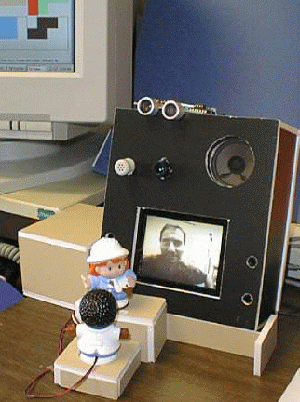Mediating Awareness, Communication and Privacy
through digital but physical surrogates

Digital but physical surrogates are tangible representations of remote people positioned within an office and under digital control. Surrogates selectively collect and present awareness information about the people they represent. By having them react to physical actions of people, surrogates can control the communication capabilities of a media space. This enables the smooth transition from awareness to casual interaction while mitigating concerns about privacy.
Three surrogates are illustrated. First, the Active Hydar surrogate, embodies the remote person via a video/audio channel. It is instrumented with a sensor that measures how close the local person is to it: the presence or absence of the audio and the quality of the video display becomes a function of proximity relative to this surrogate. When both people are close to their Hydra surrogates, they have a full audio/video channel. As one moves away from the surrogate, audio is disabled. Moving even further away degrades the video to occasional glimpses into each other's space. Second, the responding surrogate (foreground figurine) allows more explicit control of privacy by letting one express interest in the remote person: interest is shown by having the surrogate face the Hydra unit (which creates a farily open communication channel); and disinterest by tipping it over (restricting the channel). Third, the peek-a-boo surrogate (background figurine) displays non-video availability information: if the remote person is present, it faces forward. If absent, it turns away to face the wall.
Primary Investigators
Hideaki Kuzuoka, University of Tsukuba, Japan
Saul Greenberg, University of Calgary, Canada
Milestones
- Awareness Server constructed as the underlying software architecture.
- Several Hardware and Software Prototypes built to test various surrogate design.
- Active Hydra Unit installed in the offices of Kuzuoka and Greenberg in Summer, 1998.
- Usage Experiences from several months of daily use.
- Paper and Video in submission to a conference.
Current Status
- We are working on 2nd generation versions of both the hardware and software. A journal paper is in preparation.


 ucalgary.ca
ucalgary.ca